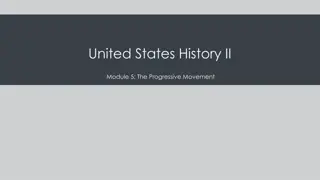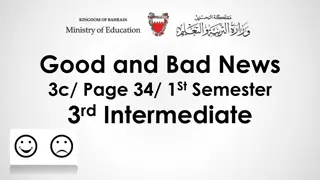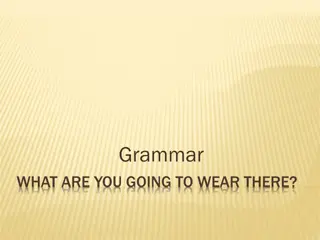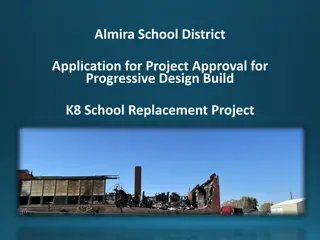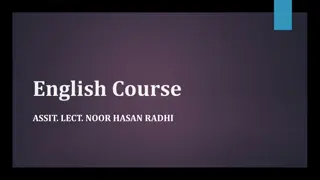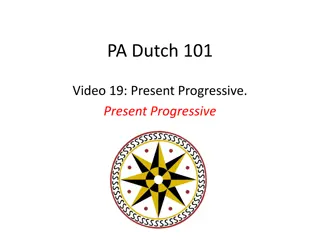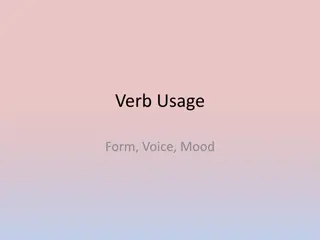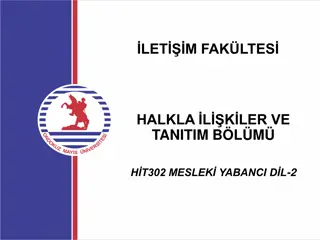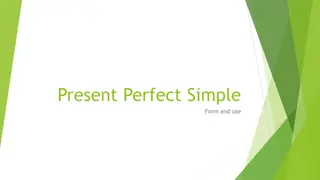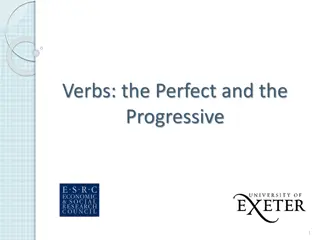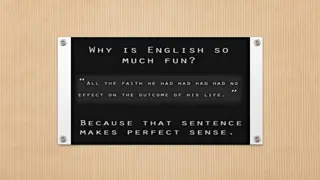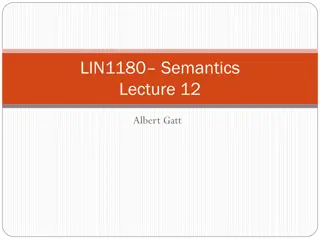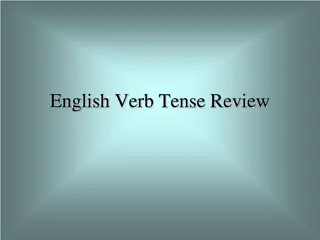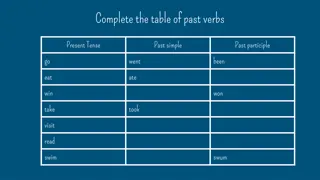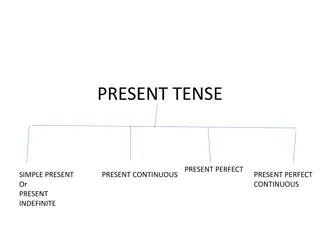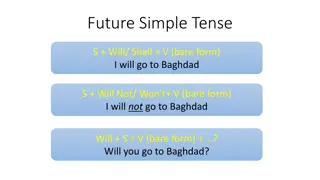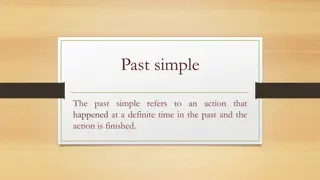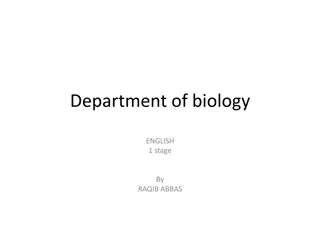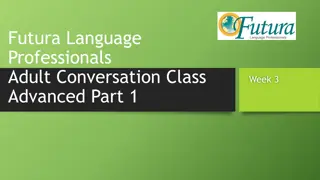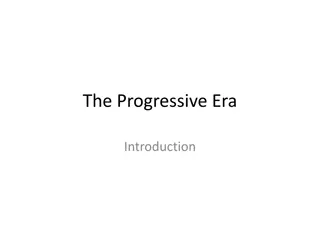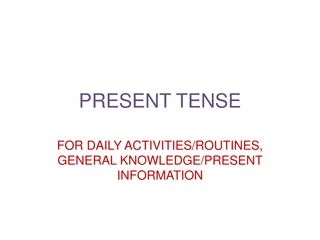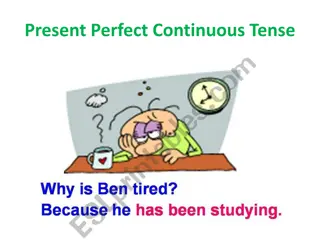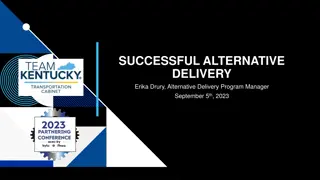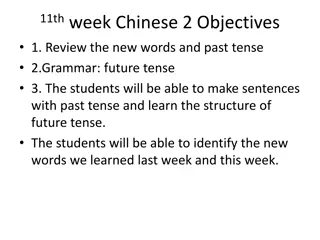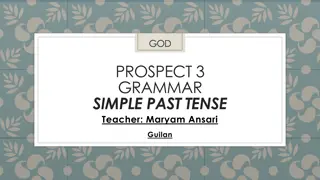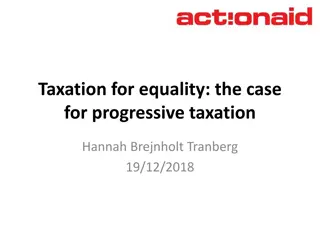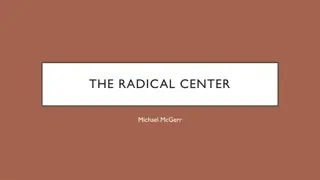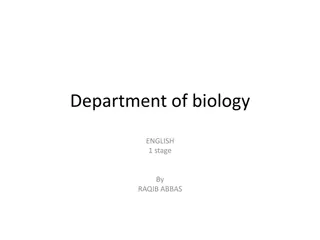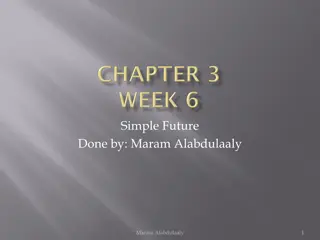Learn Past Continuous Tense - Grade 6 English Lesson
This Grade 6 English lesson focuses on understanding and correctly using the past continuous tense. It covers the rules for forming the past continuous tense, examples of its usage, and an assessment to test comprehension. Students will practice talking about actions happening at specific times in t
4 views • 6 slides
Understanding the Progressive Movement in United States History II
Explore the Progressive Movement in US History II Module 5, focusing on major movements, politics, muckrakers' role, reform leaders, women's rights, civil rights, and progressive policies under Roosevelt, Taft, and Wilson. Learn about grassroots Progressivism, social justice reformers, the Triangle
4 views • 38 slides
Learning Past Continuous Tense with Pronouns and Forming Questions
Explore how to use pronouns with "was" and "were" in the past continuous tense through examples and practice sentences. Learn to form questions using the past continuous tense and develop an understanding of when to use "was" or "were" with different subjects. Improve your grammar skills with this l
9 views • 15 slides
Good and Bad News 3c/ Page 34/ 1 St Semester 3 rd Intermediate
This educational material focuses on teaching students about using the present perfect tense and present perfect continuous tense in sentences, as well as writing letters to pen friends. It includes examples, objectives, and exercises to help students grasp the concepts effectively. Through a mix of
2 views • 23 slides
Fashion Vocabulary and Future Tense Practice Exercises
Practice exercises for learning fashion vocabulary and using the future tense. Activities include identifying clothing items, forming future tense sentences, unscrambling words, asking and answering questions about clothing preferences, and completing charts based on listening exercises. Improve you
2 views • 10 slides
Understanding Tense in English Grammar
Explore the different types of tenses such as Present, Past, and Future Tense along with their classifications like Present Indefinite Tense, Past Continuous Tense, and Future Perfect Tense. Learn how to form positive and negative sentences in each tense with examples. Enhance your knowledge of Engl
2 views • 19 slides
Learning Future Simple Tense in English Lesson
Learn how to use the future simple tense correctly in English through a lesson focused on planning a trip to France. The lesson includes reading exercises, grammar rules, error correction practice, dialogues, and more to help you understand and apply the future simple tense effectively.
2 views • 7 slides
Almira School District Progressive Design-Build K8 School Project
Almira School District's application for project approval highlights the progressive design-build approach for replacing a K8 school. The project team, led by experienced professionals, aims to negotiate scope, manage budget, secure funding, and ensure code compliance while building a new facility f
0 views • 14 slides
Understanding Regular and Irregular Verbs in Simple Past Tense
Learn how to form the simple past tense with regular and irregular verbs. Regular verbs end in "-ed," while irregular verbs have unique past tense forms. Examples and images illustrate the differences, helping you master past tense verb usage effortlessly.
0 views • 11 slides
Understanding the Past Perfect Tense in English Grammar
The Past Perfect Tense is used to talk about actions completed before a certain point in the past, emphasizing the sequence of events. This tense follows the structure of "had + past participle" and is crucial for expressing events that happened earlier than others in a narrative. Knowing how to for
0 views • 27 slides
Learning Present Progressive in PA Dutch
Explore the concept of Present Progressive in PA Dutch through examples and practice exercises. Understand the differences between the two present tense forms and learn how to form sentences in Present Progressive. Practice translating sentences using both normal conjugation and the Present Progress
0 views • 7 slides
Understanding Verb Forms: Simple, Progressive, and Emphatic
English verbs have three forms: simple, progressive, and emphatic. The progressive form consists of a form of "to be" followed by the -ing form of the verb. While some may consider progressive forms as separate tenses, they mainly reflect aspects rather than time differences. Excerpts from "Twilight
0 views • 17 slides
Understanding Simple Past Tense in English: Rules and Examples
The simple past tense is a fundamental form in Modern English used to describe past events. It involves regular verbs adding "-ed" and irregular verbs having different forms. The construction of the simple past helps distinguish it from other past tense forms like past perfect and past progressive.
0 views • 33 slides
Colorado Department of Transportation Progressive Discipline Course Overview
This course offered by the Colorado Department of Transportation focuses on Progressive Discipline, covering topics such as the process of progressive discipline, resolving performance issues, connecting performance management with discipline, and resources available for supervisors/managers. Partic
0 views • 55 slides
Learn English Grammar - Present Continuous Tense Practice
This content provides a detailed overview and practice exercises on the Present Continuous Tense in English grammar, focusing on passive voice constructions. Various examples illustrate the formation and usage of this tense, reinforcing understanding through images and exercises. Whether you are a s
0 views • 12 slides
Understanding the Past Perfect Tense in English Grammar
The past perfect tense expresses actions that occurred before another action in the past, referring to time up to a point in the past. It is often used in reported speech and formal writing to indicate completed actions before a specific event. The past perfect progressive tense emphasizes the durat
0 views • 15 slides
Understanding the Present Perfect Simple Tense and Its Usage
Learn about the basic rules, formation, and usage of the Present Perfect Simple tense in English. Explore how to form the tense, use shortened forms, understand when to use "have" and "has" with past participles, differentiate between Present Perfect and Past Simple, know when to use the Present Per
0 views • 11 slides
Understanding Verbs: Perfect vs Progressive
The concept of verbs in English is explored through the perfect and progressive forms. The National Curriculum references the use of progressive forms in Year 2 and the present perfect form in Year 3. Tense, aspect, perfect, and progressive aspects of verbs are explained with examples to illustrate
0 views • 8 slides
Understanding the Present Perfect Tense in English Grammar
The present perfect tense in English grammar is a combination of the present tense and perfect aspect used to express past events with present consequences. It is formed using the auxiliary verb "have" and the past participle of the main verb. This tense is essential for indicating completed actions
0 views • 27 slides
Understanding Future Progressive Tense in English Grammar
Future Progressive Tense, also known as Future Continuous Tense, is used to indicate actions that will be ongoing at a specific point in the future. This tense emphasizes the continuous nature of an action happening in the future. Learn how to form and use the Future Progressive Tense through exampl
0 views • 22 slides
Understanding Tense and Grammatical Aspect in Language
This lecture delves into the intricacies of tense and grammatical aspect, exploring concepts such as progressive/non-progressive, perfective/imperfective aspects across languages. It discusses the interaction between grammatical aspect and lexical aspect (Aktionsart), focusing on tense as a deictic
0 views • 43 slides
English Verb Tense Review: Simple Present and Simple Past
Simple Present Tense is used for habitual actions, unchanging truths, and general statements of fact. It is indicated by words like always, usually, and sometimes. Simple Past Tense is used for completed actions and past habits indicated by words such as yesterday and last night. The forms and indic
0 views • 46 slides
Learning Past Verbs and Present Perfect Tense
This content discusses past tense verbs through completing tables, giving examples, and exploring the present perfect simple tense with real-world scenarios. It covers verb conjugations in the past tense, such as went, ate, won, took, and swam, along with explanations and exercises related to the pr
1 views • 14 slides
Understanding Simple Present Tense and Its Usages
Simple Present Tense is used for habits, routines, and permanent truths. This tense follows a specific structure for positive, negative, and interrogative sentences. Through examples and exercises, learn how to correctly use Simple Present Tense in everyday conversations.
0 views • 8 slides
Understanding Future Simple Tense in English Grammar
The Future Simple Tense in English is used to express decisions made at the moment of speaking, announce planned future events, show willingness or unwillingness for future actions, express thoughts, and talk about events certain to happen. It is often accompanied by adverbs to indicate timing. Ques
0 views • 11 slides
Understanding Future Tense in Grammar
Future tense in grammar signifies events that have not occurred yet but are expected to happen in the future. While English lacks a distinct future tense form, it expresses future events through auxiliary verbs like will, shall, and going to. Relative tense, on the other hand, compares time referenc
0 views • 28 slides
Understanding the Past Simple Tense in English Grammar
The past simple tense refers to actions that occurred at a specific time in the past and are now completed. This tense follows a specific rule where the subject is combined with a verb (regular or irregular) and a complement. Adverbs like "yesterday," "ago," and "last" are commonly used with past si
0 views • 9 slides
Understanding Past Simple Tense in English Grammar
The past simple tense is used to describe completed actions or events that happened at a specific time in the past. Regular verbs form the past simple by adding "-ed", while irregular verbs have unique past tense forms. The structure for negative and question forms involves the auxiliary verb "did".
0 views • 6 slides
Understanding Present Continuous Tense in English Grammar
Explore the present continuous tense in English grammar through examples and explanations. Learn how to form positive, negative, and question sentences in this tense, as well as common uses such as actions happening now, future plans, temporary situations, and habitual actions. Enhance your grasp of
0 views • 50 slides
Advanced Spanish Preterite Tense Irregular Verbs and Conjugations
Dive into advanced Spanish conversation with a focus on preterite tense irregular verbs and conjugations. Practice sentence translations, engage in conversation exercises using the preterite tense, learn new vocabulary, and review general notes for past tense usage in Spanish. Explore the conjugatio
0 views • 11 slides
Understanding the Progressive Era: Origins, Movement, and Goals
The Progressive Era in late 19th century America was marked by significant political, economic, and social reforms. Originating from the need to address injustices and restore economic opportunities, the Progressive Movement aimed to create lasting changes in society. With goals including protecting
0 views • 12 slides
Present Tense: Daily Activities & Information
Explore the present tense for daily routines, general knowledge, and current information in this informative content. Discover what activities are usually done on Saturday evenings and Sunday mornings, learn about the ministers in charge of Maritime and Fisheries Affairs and Agriculture, and get fam
0 views • 10 slides
Understanding the Present Perfect Continuous Tense
The Present Perfect Continuous Tense is used to emphasize the duration of an action that started in the past and continues up to the present, indicating ongoing actions with time expressions like 'for,' 'since,' 'all morning,' etc. Learn how to use this tense correctly and distinguish it from the Pr
1 views • 10 slides
Progressive Contracting Methods in Infrastructure Projects
Progressive contracting methods, such as Progressive Design Build (PDB) and Construction Manager/General Contractor (CM/GC), are being actively utilized by KYTC for infrastructure projects. These methods offer benefits like better risk mitigation and price certainty. Learn about the differences betw
0 views • 14 slides
Chinese Language Learning Objectives for 11th Week - Reviewing New Words and Future Tense
This instructional plan outlines the objectives for the 11th week of a Chinese language course. Students will review new vocabulary words and past tense, learn about the future tense, practice making sentences, and prepare for presentations. The content includes Monday's objectives, a review of new
0 views • 12 slides
Understanding Simple Past Tense in Grammar
In this file, we delve into the concept of simple past tense in grammar. Through examples and explanations, you will learn how to use the simple past tense to talk about completed actions in the past. The structure, usage, and importance of simple past tense are covered extensively to enhance your u
0 views • 30 slides
The Case for Progressive Taxation: Ensuring Equality Through Fair Contributions
Progressive taxation involves higher tax rates for individuals with higher incomes or greater wealth, aiming to bridge economic and gender inequalities. This system can be achieved through well-designed tax scales, exemptions, and thresholds, ultimately contributing to fair distribution of contribut
0 views • 8 slides
The Radical Center: Jane Addams and the Progressive Movement
This chapter explores the life journey of Jane Addams and her role during the Progressive Era. It reflects on how societal changes, women's independence, and collective struggles shaped the middle class, challenging traditional norms. The chapter discusses the emergence of the progressive movement d
0 views • 5 slides
Department of biology
The present continuous tense, also known as the present progressive tense, is used to describe ongoing actions or events happening in the present. It is formed by using the present tense of the verb "to be" followed by the -ing form of the main verb. Learn about forming positive, negative, and quest
0 views • 5 slides
Understanding Simple Future Tense in English Grammar
Simple Future Tense is used to express actions that will happen in the future. It is formed using "will" or "be going to" and can also involve expressions like "shall." This tense is used for predictions, plans, willingness, and decisions made at the moment of speaking. Learn how to form affirmative
0 views • 20 slides

